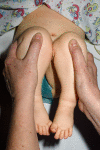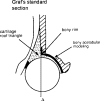Screening and treatment in developmental dysplasia of the hip-where do we go from here?
- PMID: 21553044
- PMCID: PMC3167447
- DOI: 10.1007/s00264-011-1257-z
Screening and treatment in developmental dysplasia of the hip-where do we go from here?
Abstract
Purpose: Developmental dysplasia of the hip (DDH) is a leading cause of disability in childhood and early adult life. Clinical and sonographic screening programmes have been used to facilitate early detection but the effectiveness of both screening strategies is unproven. This article discusses the role for screening in DDH and provides an evidence-based review for early management of cases detected by such screening programmes.
Methods: We performed a literature review using the key words 'hip dysplasia,' 'screening,' 'ultrasound,' and 'treatment.'
Results: The screening method of choice and its effectiveness in DDH still needs to be established although it seems essential that screening tests are performed by trained and competent examiners. There is no level 1 evidence to advise on the role of abduction splinting in DDH although clinicians feel strongly that hip instability does improve with such a treatment regime. The definition of what constitutes a pathological dysplasia and when this requires treatment is also poorly understood.
Conclusion: Further research needs to establish whether early splintage of clinically stable but sonographically dysplastic hips affects future risk of late-presenting dysplasia/dislocation and osteoarthritis. There is a need for high quality studies in the future if these questions are to be answered.
Figures




Comment in
-
Comment on Sewell and Eastwood: Screening and treatment in developmental dysplasia of the hip--where do we go from here?Int Orthop. 2012 Jul;36(7):1529. doi: 10.1007/s00264-012-1551-4. Epub 2012 Apr 28. Int Orthop. 2012. PMID: 22539161 Free PMC article. No abstract available.
References
-
- Mackenzie IG, Wilson JG. Problems encountered in the early diagnosis and management of congenital dislocation of the hip. J Bone Joint Surg Br. 1981;63:38–42. - PubMed
-
- Harris WH. Etiology of osteoarthritis of the hip. Clin Orthop Relat Res. 1986;213:20–33. - PubMed
-
- Furnes O, Lie SA, Espehaug B, Vollset SE, Engesaeter LB, Havelin LI. Hip disease and the prognosis of total hip replacements. A review of 53,698 primary total hip replacements reported to the Norwegian Arthroplasty Register 1987–99. J Bone Joint Surg Br. 2001;83:579–86. doi: 10.1302/0301-620X.83B4.11223. - DOI - PubMed
-
- Klisic PJ. Congenital dislocation of the hip—a misleading term. J Bone Joint Surg Br. 1989;71:136. - PubMed
Publication types
MeSH terms
LinkOut - more resources
Full Text Sources
Research Materials

